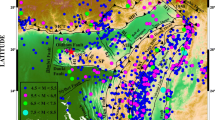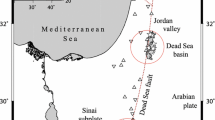Abstract
During 2017–2019, a temporary seismic network of fifty-five 3-component broadband seismometers was installed by CSIR-NGRI, Hyderabad, Telangana, in the Uttarakhand Himalayan region, India. We used digital waveform data of 21 local earthquakes of Mw 2.9–4.3 from nineteen 3-component broadband seismic stations of the above seismic network for computing source parameters of local earthquakes, through simultaneous inversion of shear wave (S-wave) spectra. Here, we used the ω square circular source spectral model of Brune (1970) to formulate the iterative inversion scheme to compute earthquake source parameters. The modelled corner-frequency (fc), source radius (r), seismic moment (Mo) and stress-drop (Δσ) vary from 2.4 to 4.0 Hz, 247–693 m, 2.4 × 1013 to 6.6 × 1015 N-m, 0.2–5.4 MPa, respectively. The maximum stress-drop (Δσmax) is computed to be 5.4 MPa for an event of Mw 4.3 while the minimum stress drop (Δσmin) is computed to be 0.2 MPa for an event of Mw 2.9. The scaling relations between Mo and fc is obtained as Mo = 3.2E + 17fc−5.5, while Mo and Δσ are modelled to be related as Mo = 4.59E + 13∆σ2.5. This relationship could be very useful for the future seismic-hazard assessment of the Uttarakhand Himalayan region.
Research Highlights
-
Modelled source parameters of local earthquakes and scaling relationship in the Uttarakhand Himalayan region.
-
Local earthquakes magnitude range of 2.9–4.3.
-
Mo, r, fc, and ∆σ are 2.4×1013–6.6×1015 N-m. 247.0–693.0 m, 2.4–4.0 Hz, 0.2–5.4 MPa, respectively.
-
Mo fc5.5 \(\propto\) constant & Mo∆σ2.5 \(\propto\) constant.




Similar content being viewed by others
References
Aki K 1965 Maximum likelihood estimate of b in the formula log N = a–bM and its confidence limits; Bull. Earthq. Res. Inst. Univ. Tokyo 43 237–239.
Aki K 1967 Scaling law of seismic spectrum; J. Geophys. Res. 72 1217–1231.
Aki K and Richards P G 1980 Quantitative seismology; Vol. I, W.H. Freeman and Company, New York.
Boatwright J 1980 A spectral theory for circular seismic sources: Simple estimates of source dimension, dynamic stress drop and radiated energy; Bull. Seismol. Soc. Am. 70 1–27.
Brune J N 1970 Tectonic stress and the spectra of seismic shear waves from earthquakes; J. Geophys. Res. 75 4997–5009.
Dutta U, Biswas N, Martirosyan A, Papageorgiou A and Kinoshita S 2003 Estimation of earthquake source parameters and site response in Anchorage, Alaska from strong motion network data using generalized inversion method; Phys. Earth Planet. Int. 137(1–4) 13–29.
Fletcher J B 1995 Source parameters and crustal Q for four earthquakes in South Carolina; Seismol. Res. Lett. 66 44–58.
Hanks T C and Kanamori H 1979 A moment magnitude scale; J. Geophys. Res. 84 2348–2350.
Kanamori H and Rivera L 2004 Static and dynamic scaling relations for earthquakes and their implications for rupture speed and stress drop; Bull. Seismol. Soc. Am. 94 314–319.
Keilis-Borok V I 1959 An estimation of the displacement in earthquake source and of source dimensions; Ann. Geophys. 12 205–214.
Kumar D, Sriram V, Sarkar I and Teotia S S 2008 An estimate of a Scaling Law of seismic spectrum for earthquakes in Himalaya; Indian Minerals 61(3–4) 83–92.
Kumar M, Yallanki S V, Biswas K and Mandal P 2015 Evidence for non-self-similarity in the Mw 7.7 2001 Bhuj earthquake sequence; Nat. Hazards 75 1577–1598, https://doi.org/10.1007/s11069-014-1381-3.
Kumar V, Kumar D and Chopra S 2016 Estimation of source parameters and scaling relations for moderate size earthquakes in north-west Himalaya; J. Asian Earth Sci. 128 79–89.
Kumar V, Kumar D and Chopra S 2019 Source parameters and scaling relations for moderate size earthquakes in north-east India region; Pure Appl. Geophys. 176 45–64, https://doi.org/10.1007/s00024-018-1972-0.
Madriaga R 1976 Dynamics of an expanding circular fault; Bull. Seismol. Soc. Am. 66 639–666.
Mahesh P, Rai S S, Sivaram K, Paul A, Gupta S, Sharma R and Gaur V K 2013 One-dimensional reference velocity model and precise locations of earthquake hypocenters in the central (Kumaon–Garhwal) Himalaya; Bull. Seismol. Soc. Am. 103 328–339.
Mandal P, Padhy S, Rastogi B K, Satyanarayana H V S, Kousalya M, Vijayraghavan R and Srinivasan A 2001 Aftershock activity and frequency-dependent Low Coda Qc in the epicentral region of the 1999 Chamoli Earthquake of Mw 6.4; Pure Appl. Geophys. 158 1719–1735.
Paul A, Tiwari A and Upadhyay R 2019 Central seismic gap and probable zone of large earthquake in northwest Himalaya; Him. Geol. 40(2) 199–212.
Press W H, Teukolsky S A, Vetterling W T and Flannery B P 1992 Numerical recipes in FORTRAN and C; Academic Press, New York, 382p.
Singh B and Mandal P 2020 Modeling of earthquake locations and source parameters in Kachchh region to understand genesis of earthquakes; J. Earth Syst. Sci. 129 31, https://doi.org/10.1007/s12040-019-1290-7.
Sivaram K, Kumar D, Teotia S S, Rai S S and Prakasam K S 2013 Source parameter scaling relations for small earthquakes in Kumaon Himalaya, India; J. Seismol. 17 579–592, https://doi.org/10.1007/s10950-012-9339-y.
Tiwari A, Paul A, Singh R and Upadhyay R 2021 Potential seismogenic asperities in the Garhwal–Kumaun region, NW Himalaya: Seismotectonic implications; Nat. Hazards 107(1) 73–95, https://doi.org/10.1007/s11069-021-04574-3.
Tiwari A, Sain K, Kumar A, Tiwari J, Paul A, Kumar N, Haldar C, Kumar S and Pandey C P 2022 Potential seismic precursors and surficial dynamics of a deadly Himalayan disaster: An early warning approach; Sci. Rep. 12 3733, https://doi.org/10.1038/s41598-022-07491-y.
Valdiya K S 1980 Geology of Kumaun Lesser Himalaya; Interim Record: Wadia Institute of Himalayan Geology, Dehradun, India, 291p.
Watanabe K, Sato H, Kinoshita S and Ohtake M 1996 Source characteristics of small to moderate earthquakes in the Kanto region, Japan: Application of a new definition of the S-wave time window length; Bull. Seismol. Soc. Am. 86 1284–1291.
Acknowledgements
Our present study is supported by the CSIR-funded Mission mode project on ‘Safety and security of vital installations’. Authors are grateful to the Director, CSIR-NGRI, Hyderabad, Telangana, for his kind permission to publish our present work. This article, bearing the WIHG contribution No. WIHG/0267.
Author information
Authors and Affiliations
Contributions
The modelling and computation of earthquake source parameters are done by Abhishek Kumar Gupta (AKG). Interpretation of geodynamic models of the region done by Prantik Mandal (PM). Collection of data and processing is done by AKG and PM. MS writing, discussions, and interpretation were done by AKG and PM, and KS contributed to writing and editing.
Corresponding author
Additional information
Communicated by Somnath Dasgupta
Rights and permissions
About this article
Cite this article
Gupta, A.K., Mandal, P. & Sain, K. Modelling of earthquake source parameters and scaling relations in the Uttarakhand Himalayan region, India. J Earth Syst Sci 132, 73 (2023). https://doi.org/10.1007/s12040-023-02082-5
Received:
Revised:
Accepted:
Published:
DOI: https://doi.org/10.1007/s12040-023-02082-5




